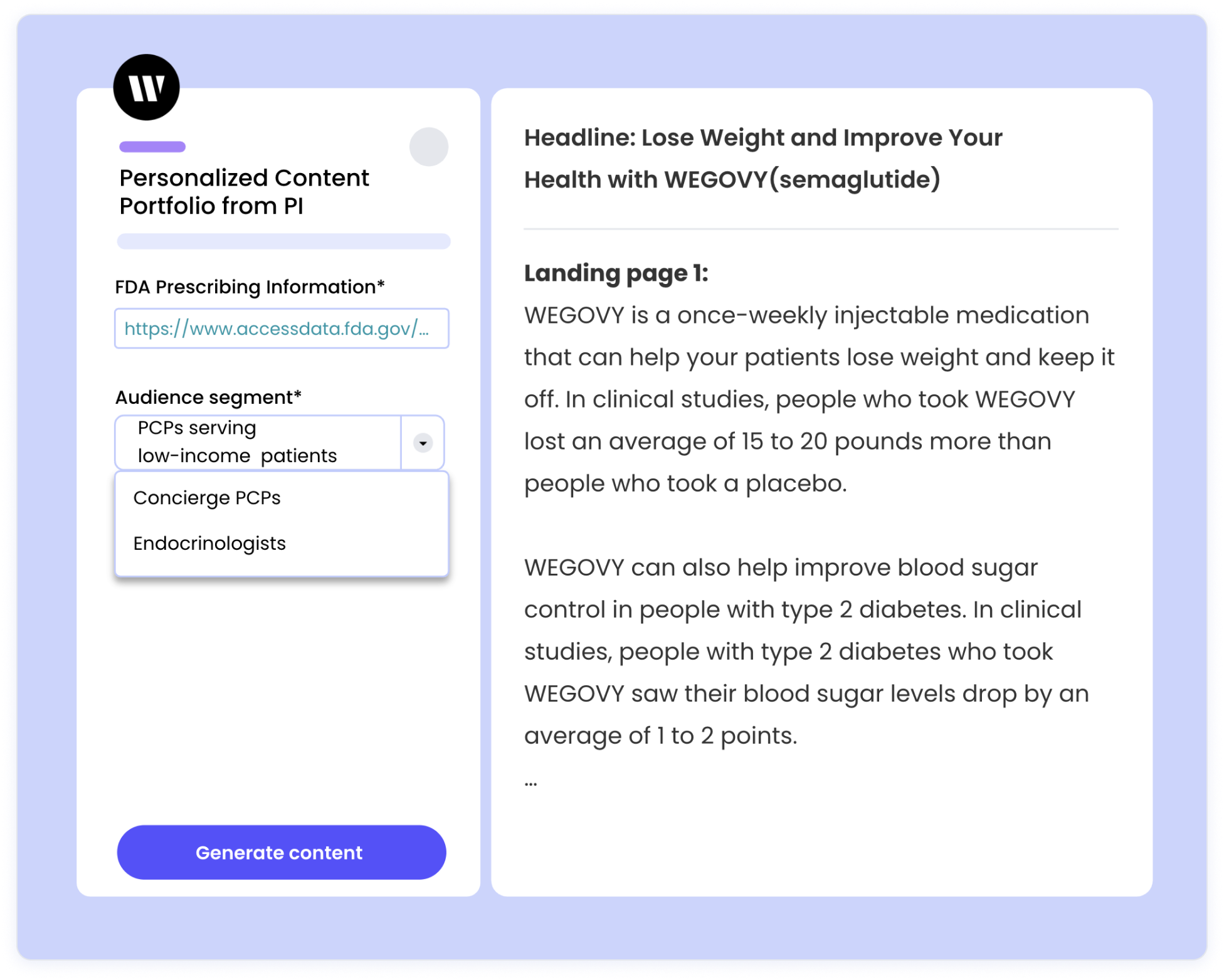AI agents at work
– 10 min read
How life science businesses transform communications using enterprise generative AI

Medical communications teams at life science companies face an ever-growing corpus of knowledge. From real-world evidence to peer-reviewed literature to patient-generated content, gathering and disseminating information appropriately across channels is a growing challenge. Turning that information into engaging campaigns that increase awareness, discussion, and sales is a time-consuming, costly process.
Between stiff competition and tightened reimbursement landscapes, life science executives are asking themselves: can technology help us communicate better with doctors and patients and cut costs at the same time?
Our experience at WRITER suggests that the answer is “yes.”
MedComms teams at major pharmaceutical brands are embracing our full-stack generative AI platform for its unparalleled ability to distill medical documents and intricate scientific data, produce personalized commercial content at scale, and swiftly adapt it to various formats — all while upholding stringent regulatory standards and brand integrity.
Research-based companies like Caidya are seeing unprecedented savings and growth opportunities in customer engagement, product marketing, growth marketing, and field sales enablement. In a recent WRITER customer spotlight, Heather Varela, Caidya’s VP of Global Marketing and Communications, reported that her team is bringing content and campaigns 66% faster to market. Work that took hours is now taking minutes.
“What I wish I would have known sooner is how valuable this tool is in increasing productivity and being such a time saver,” Heather told us. “I would encourage people who are starting to dip their toe in the generative AI pool to think about some of the ways that they are spending their time currently and what of that work could you offload.”
The proof doesn’t stop with our customers. McKinsey reports that generative AI will propel $18-$30 billion in value annually through commercial life sciences (pharma) use cases like personalized content creation, medical and legal review assistance, customer enablement, strategic insights, and patient experience optimization. The same report predicts an additional $3 to $5 billion in annual value through efficiency gains in customer-insight generation, better-quality medical writing, and rapid summaries of scientific literature.
For communications teams at life sciences companies, the question isn’t if you’ll be using generative AI in your work — it’s “what’s the best way to start?”
Let’s explore some key areas where generative AI can be used in medical communications today.
- Generative AI platforms are transforming medical communications for life science companies, enabling faster content creation and adaptation to various formats while maintaining regulatory standards and brand integrity.
- Medical-specific generative AI solutions can summarize complex scientific information, distilling dense scientific articles and clinical trial results into plain language in seconds.
- Generative AI allows for rapid and hyper-personalized content creation, enabling medical marketing and communications teams to deliver localized and targeted content to different channels and audience segments.
- Accuracy and precision are crucial in medical communications, and generative AI platforms equipped with large language models fine-tuned for healthcare and life sciences industry use cases can ensure highly accurate output.
- Generative AI streamlines and automates Medical-Legal-Regulatory (MLR) review processes — easing bottlenecks, and helping to ensure compliance with brand guidelines, regulatory requirements, and medical accuracy, reducing review time and the risk of fines.
AI accelerates and improves medical communications
One of the challenges of medical communications is distilling complex information into a format appropriate for its audience. Medical-specific generative AI solutions can produce a first draft of content, brainstorm ideas based on newly published documentation, and craft emails, landing pages, and social posts in a fraction of the usual time. At all stages of the production process, generative AI fuses medical knowledge with the tone and format appropriate for the audience. This combination of speed and personalization is already revolutionizing medical communications for the most forward-thinking life-sciences firms.

It can take hours for a human to read and digest a new research publication. And that’s only the first step — the information then needs to be transformed into a format for its intended audience.
Generative AI is ideal for this task. In seconds, it will summarize a dense scientific article or turn clinical trial results into plain language. It can also easily take that information and draft an email announcement appropriate for a primary care provider or GP.

Volume isn’t a barrier for generative AI. Large language models can digest and synthesize scientific papers, patient data, and other medical content. A human would need to cross-reference what they’ve read through notes (or an excellent memory), whereas generative AI immediately extracts insights and key findings.
Rapid, hyper-personalized content
Speed is essential in medical communications — doctors, researchers, and patients all want the most up-to-date medical content — but rushing the writing process often leads to generic, impersonal content.
Generative AI enables an exponential increase in personalization — delivered in record time. Medical marketing and communications teams can instantly personalize content for different channels, such as creating localized content or targeting a micro-segment of the population. Generative AI can also modify existing content to meet the regulatory requirements of different countries — not just translation, but true localization.
Repurposing existing content for different formats is a key time-saving tactic for communications teams, and AI makes it faster and easier than ever to transform content for different channels and audience segments. Not only does this save time — it also improves the patient experience by delivering accessible, educational content tuned to their individual needs based on condition, demographics, or location.
Highly accurate output — with the right platform and inputs
Accuracy and precision are imperative in medical communications, and the risk of AI hallucinations are a looming — and valid — concern. LLMs want to answer questions with coherent answers, but when a model can’t find the answer in its existing training data, it can confidently and convincingly make up facts.
That’s why we consider three factors essential to a successful generative AI solution for medical comms teams:
- A large language model (LLM) fine-tuned for healthcare and life sciences industry use cases. You need models that are trained on medical knowledge and equipped to handle complex, healthcare-specific tasks. Palmyra Med, our healthcare-specific LLM, is an example of such a model — we’ll discuss more about it later in this article.
- Access to existing internal documentation and written resources, and the ability to retrieve and contextualize such information. Without this, the output is confined to information publicly available to train the LMM and doesn’t reflect the full scope of your business’s medical knowledge. The technical solution for this is called retrieval-augmented generation (RAG).
- A secure platform that automatically enforces your AI guardrails so work is compliant, accurate, inclusive, and on-brand, whether it’s created by your people or AI. That means flagging language that runs afoul of legal and regulatory rules, including claims and incorrect terminology, and having features for data loss protection, global compliance, and plagiarism detection.
The WRITER RAG solution, Knowledge Graph, creates a proprietary knowledge base for your brand, disease area, products, or specialty. With Knowledge Graph, your users can query internal knowledge for accurate, company-specific insights.
Generative AI can modify existing content in a fraction of the time of manual efforts. For example, let’s say a journal rejects an article your team submits for publication. With generative AI, you can transform the article to meet the style guidelines of a different publication in minutes. If a new indication from the FDA or other regulatory body requires modifications to your existing content, WRITER can do a bulk update via APIs so that your approved content library remains accurate.
Get an overview of Knowledge Graph, the graph-based RAG solution from WRITER. Take a quick tour.
AI streamlines and automates MLR review
Every life-sciences organization has its own version of Medical-Legal-Regulatory (MLR) review, which is often a bottleneck in content production. The relationship between the communications team and those in charge of safety, accuracy, and compliance can often be tense. How can you get content into the world quickly so it can have the greatest impact while assuring that content is medically accurate and adheres to laws and regulations?
With generative AI, comms teams can pre-check materials before final review, flagging and helping to rewrite content for compliance with brand and corporate guidelines as well as FDA OPDP, FTC, and other regulatory requirements.

Reviewers can employ AI in driving medical accuracy by quickly identifying medical claims and comparing them with a source of truth. Generative AI can flag implicit and explicit claims for easy identification and evaluation.
Equally important is the ability to adhere to health authority copy and imagery regulations. Generative AI, for instance, can be trained to steer clear of superlative language and follow guidelines for the positioning and presentation of brand and generic drug names in the content it produces.
Finally, with generative AI, writers and reviewers can ensure the presence of Important Safety Information (ISI) and the balance of risk/benefits in communications.
With a generative AI platform, medical comms teams can reduce MLR review time from 30%-50%, increase first-pass MLR approvals by 20%-30%, and dramatically reduce the risk of fines and censure.
Want to see more? Take a quick tour of an MLR visual review app built in WRITER.
Industry-specific platforms make generative AI easy to use
For all their potential, most generative AI tools aren’t well-suited for life sciences. Widely available products like ChatGPT have data privacy issues and put sensitive information at risk.
Any generative AI tool that relies on prompt engineering at the end-user level is hard to adopt. A report from Accenture found that most companies are “significantly underinvesting in helping workers keep up with the advances of AI.” Prompts can be the difference between generative AI output that needs minimal human interaction and output that needs a lot of work. Requiring all employees to be savvy prompt engineers undermines the effectiveness — and the ROI — of generative AI.
A full-stack generative AI platform like WRITER reduces the need for every user to be good at writing prompts. Only a small number of power-users within an organization need to understand prompt engineering and can leverage their expertise across a broad swath of front-line uses.
For example, within WRITER, organizations build AI apps that require only a few user inputs. To create a new medical product landing page, a user might reference a URL or upload a PDF, select an audience segment from an internal predefined list, and select “generate content.” This creates a consistent, repeatable process that doesn’t require any prompt knowledge from the users.

Unlike chat-based generative AI interfaces that require extensive prompting, WRITER has democratized access to generative AI. Thousands of staff can rely on Palmyra Med, an LLM designed for healthcare, and AI apps tailored to their organization’s use cases. WRITER keeps your sensitive data safe and segmented from other WRITER customers, and WRITER is compliant with the latest privacy and security standards.
Read more about data privacy and security when implementing generative AI here.
The future is now: Generative AI redefines communication in life sciences
Generative AI solutions are revolutionizing the life science industry, empowering companies to communicate with patients and doctors in a whole new way. By automating content generation, improving scientific communication, streamlining the MLR review process, and enhancing patient recruitment efforts, generative AI is transforming the landscape of life science communications. With these advancements, companies can rapidly produce personalized and compliant content at scale, freeing up scientists to focus on groundbreaking research and ultimately accelerating the development of life-saving treatments. The future of life science communications is here, and generative AI is leading the way towards a more efficient, impactful, and patient-centric approach.
Learn how the WRITER generative AI platform empowers medical communications teams and beyond in the life sciences: Request a demo.




